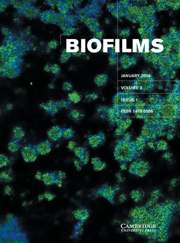The A-factor regulatory cascade that leads to morphological development and secondary metabolism in Streptomyces
Published online by Cambridge University Press: 05 April 2005
Abstract
A-factor (2-isocapryloyl-3R-hydroxymethyl-γ-butyrolactone) is a chemical signalling molecule, or microbial hormone, that triggers aerial mycelium formation and secondary metabolism in Streptomyces griseus. A-factor pro- duced in a growth-dependent manner switches on the transcription of adpA, encoding a transcriptional activator, by binding to ArpA, the A-factor receptor protein, which has bound to the adpA promoter, and dissociating the bound ArpA from the DNA. AdpA then activates a number of genes of various functions required for morphological development and secondary metabolism, forming an AdpA regulon. ArpA, which belongs to the TetR family, contains a helix–turn–helix DNA-binding motif in its N-terminal portion and an A-factor-binding pocket (5 Å (0.5 nm) diameter and 20 Å (2 nm) long) in its C-terminal portion, as implied by X-ray crystallography of CprB, an ArpA homologue. The ligand pocket, which can accommodate an entire A-factor-type molecule of γ-butyrolactone, is completely embedded in the C-terminal portion. Upon binding A-factor, a long helix connecting the A-factor-binding and ligand-binding domains is relocated, as a result of which the DNA-binding helix moves outside, resulting in dissociation from DNA. AdpA, which belongs to the AraC/XylS family, contains a ThiJ/PfpI/DJ-1-like dimerization domain in its N-terminal portion and an AraC/XylS-type DNA-binding domain in its C-terminal portion. For transcriptional activation, AdpA can bind to various positions with respect to the transcriptional start points of the target genes and sometimes to multiple sites. We show here how A-factor triggers secondary metabolism and morphological development in S. griseus, with emphasis on the two key transcriptional factors, ArpA and AdpA, in the A-factor regulatory cascade.
- Type
- Review Article
- Information
- Copyright
- © 2005 Cambridge University Press
- 12
- Cited by


